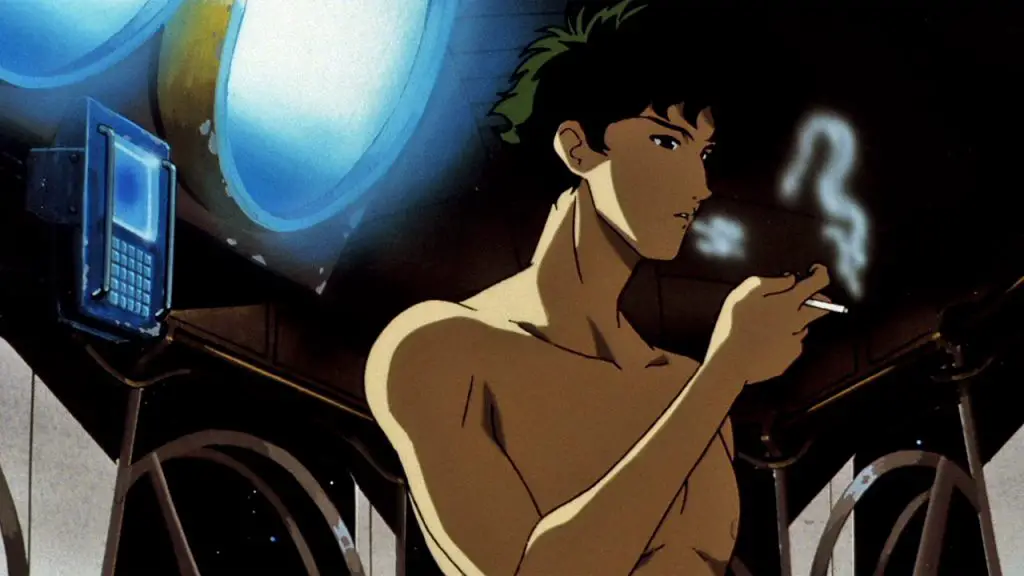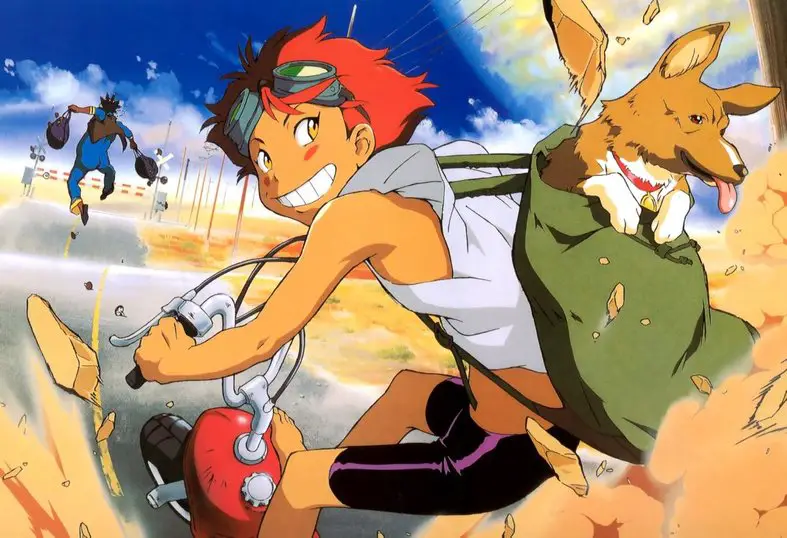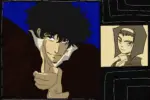There’s a haunting, harrowing line boldly claimed by Spike Spiegel, the endlessly likable protagonist of the classic, universally acclaimed anime series “Cowboy Bebop,” during the show’s gut-wrenching finale as he departs his ship and crew to confront the demons of his past, potentially making the ultimate sacrifice to settle a long overdue score.
It’s a line that echoes through the pained silence of Faye Valentine, “Bebop’s” deeply compelling and damaged female lead, after she desperately pleads with Spike to remain aboard and ignore the ghosts of his past, a line that resonates so vividly with her personal experience that she’s rendered effectively speechless. It’s a line that shakes jaded ship captain Jet Black, Spike’s longtime bounty hunting partner, so thoroughly that he remains off-screen, unwilling to witness yet another close friend depart prematurely during his life, one that has been laced with perpetual frustration and loneliness. More than explaining any one character’s precarious instability, however, this powerful, poignant final proclamation concisely summarizes “Bebop’s” unique thematic core, one that cements it as one of the premiere examples of mature, adult-oriented philosophical storytelling across any visual medium.
Spike’s iconic line to the Bebop crew, the one that “Bebop” fans would collectively remember for decades to come, goes as such: “I felt like I was watching a bad dream I’d never wake up from.”
Now, nearly twenty years after the Bebop crew left viewers with a bittersweet, satisfying ending, it has been announced that Tomorrow ITV Studios, a Los Angeles-based film company, has been greenlit to begin production on a U.S. live-action revival of the beloved franchise. Though they’ll be in partnership with Sunrise, Inc., the original Japanese studio behind “Bebop,” the adaptation will be co-produced in the West and has already pegged Chris Yost (“Thor: The Dark World”) as its lead screenwriter.

Considering Hollywood’s history in adapting Eastern animation to Western theaters, fans are understandably disgruntled over the announcement. 2009’s infamous “Dragonball: Evolution,” widely reviled by filmgoers and animation connoisseurs alike, abandoned the fun and adventure of the original animated series in favor of angsty high school melodrama, a critical and financial disaster. Though 2017’s Hollywood adaptation of “Ghost in the Shell” paid more respect to its source material by attempting to deliver a faithful reimagining, it largely came up short of the original’s lofty philosophical cinematic achievements. Even though Netflix’s “Death Note” won’t be releasing until later this year, early trailers indicate a similar mishandling of the famous original story, seemingly devolving genius prodigy main character Light Yagami into an overly conspicuous American teenager, while simultaneously bloating the story with superfluous action scenes absent in the original plot.
The Western tendency to bungle anime adaptations is as consistent as it is concerning for the future of “Bebop”; that is to say, the outlook is grim and there’s very little room for optimism. Like Spike at the end of his troubled journey, anime fans are witnessing a bad dream they can’t wake up from, filled with disappointment after disappointment, one poor adaptation after another, with no respite to the nightmare of reality. However, “Bebop” is a special case from the others, though not as a beacon of hope for a proper Western reimagining; sadly, evidence speaks to the contrary.
In theory, it would have been possible to craft faithful depictions of both “Dragonball” and “Ghost in the Shell.” The former follows a simple cause-and-effect adventure narrative that Hollywood revels in, presenting the possibility for a compelling script following the standard three-act structure of cinematic storytelling; while the latter, though considerably more complex, exists in a flexible futuristic setting that has allowed for constant creative freedom across multiple successful animated reimaginings, including a two-season television run and a reboot film series. In retrospect, it’s reasonable to see why western producers would be willing to take a risk on such properties, misguided though their attempts eventually turned out to be.
Alternatively, “Bebop’s” unique structure and nuanced visual direction restrict comparable potential for the upcoming live action release. Even among its own medium, “Bebop” has always existed in a genre of its own, hence the titular allusion to the jazz style born from the same originality. It’s so distinct, such a lightning-in-a-bottle success, that barely any anime have dared try emulating the model of its character development and narrative progression, much less any American productions. “Bebop’s” storytelling style is so foreign to Hollywood live action filmmaking that the concept of a Western adaptation presents an almost impossible challenge to tackle; in concept alone, it’s dead on arrival.
“Bebop” explores mature, adult themes through a strikingly unique method of plot progression that rests at the polar opposite end of the storytelling spectrum from the established Hollywood formula, namely that its episodes collectively compile an epilogue to a story that’s already happened. The plot ostensibly follows the suave Spike Spiegel, his occupational partner Jet Black, the wild card Faye Valentine and the playful duo of Ed and Ein aboard a ship called the Bebop as they look to make an honest living through various misadventures in the bounty-hunting business, but this is merely a thinly veiled framework for the real stories that have transpired long before the opening scene of Episode 1. Spike turns out to be a former member of a crime syndicate who tragically fell in love with his former partner’s girlfriend and fled the organization before joining the Bebop, and it’s through him that the viewer learns the futility of escapism. People can’t truly escape the demons of their past, no matter how strongly they may desire to do so.
Through Jet, a former honest cop who was brutally betrayed and robbed of his arm by his contemporaries, on top of being abandoned by his former lover, the viewer is most prominently informed that trying to control a corrupt, chaotic world through order and virtue is ultimately a fruitless endeavor. Faye, possessing arguably the most brutal backstory, wakes up from a fifty-year cryogenic sleep with no memories and no home to return to, eventually being manipulated, betrayed and abandoned by the man who helped her assimilate into the new world and left with a debt of over 300 million woolongs (the in-universe currency). Through her backstory, the viewer learns that getting close to others is a dangerous gamble, as, in all likelihood, they will leave sooner or later, allowing a void of distrust to fester in an individual where human camaraderie previously thrived.

These are all tragic, brilliantly written backstories, but they all take place long before the Bebop crew hunts its first bounty, and they’re certainly not why people care so deeply for these characters, as the viewer rarely witnesses these events unfold onscreen. Instead, “Bebop” revels in the aftermath, showing how these terribly scarred characters cope with the trauma of their pasts on a regular basis. Spike practices martial arts and tinkers with his spaceship, Jet waters his bonsai farm and Faye acquires a nasty gambling habit. “Bebop” goes to great lengths in deliberately showing the viewer these actions, whether the crew is assembled in the same room or if they’re off on their own separate adventures.
Fifteen of the twenty-six episodes in the series have absolutely nothing to do with any backstories, and are often episodic romps involving the main cast while also featuring supporting one-off characters that are thoroughly explored and elegantly characterized enough in twenty minutes to have an entire television series of their own. However, things inevitably turn somber by the conclusion of nearly any given episode, resulting in further trauma for the main characters and an increasing demand for their respective methods of distraction; their hobbies make sense as tools for maintaining sanity in an oftentimes bleak, contingent universe. This is how “Bebop” achieves a shocking level of relatability and maturity that very few shows can replicate. It understands that tragedy exists to some degree in everyone’s lives, a sad fact that only becomes accentuated with age, and that adults have to discover methods of handling the tremendous burden of trauma or risk being crushed by the overwhelming weight of it. “Bebop” isn’t about showing tragic stories; it’s about intricately exploring characters who have already endured them.
This is precisely why a live action westernized “Bebop” is such a bewildering concept, as the original series directly opposes the established Hollywood three-act structure of storytelling. Traditionally, American films and television programs organize their scripts around an introduction-conflict-resolution formula: The protagonist and all relevant characters are explored in act one, including motivations for action and progression; act two presents the major roadblock of the plot for the heroes to overcome, and the third act resolves this antagonistic force, usually with substantial amounts of fanfare. Thus, a story is born and concluded.
Western audiences enjoy seeing tangible plot progression and character development at a reasonable pace with little fluff or meandering. Even in episodic television shows, an overarching conflict usually presents itself to the main characters, gradually being solved over an extended period of time. However, this direct form of storytelling and linear character exploration counters everything that “Bebop” accomplished, and it could threaten the distinct identity it forged during its original twenty-six-episode run. It’s exactly the reason why confirmation of a Hollywood adaptation is so concerning to fans of the anime masterpiece.
A story does exist in “Bebop,” and perhaps the live action television series will explore the pasts of Spike, Jet and Faye as its central focus. Maybe the myriad events transpiring before the first episode of the anime will be the narrative core of the new show, ending with the Bebop crew forming for the first time as a graceful segue into where the original series begins. Such a direction would certainly be more in line with Hollywood’s storytelling tactics. Such a story might even be great. But even if that were to happen, the resulting series wouldn’t capture what made the original so special. It wouldn’t be “Bebop.”
The only possible solution to this dilemma, then, is remaking the original series as faithfully as humanly possible. However, even if the live action remake painstakingly recreates the anime scene for scene and shot for shot, it still won’t hold a candle to the “Bebop” anime. One of the main ingredients involved in “Bebop’s” perfect blend of innovation is its medium specificity; in order for the characters to properly come alive, they must be portrayed in animation. The most obvious example of this is the Bebop crew’s outlier child character, Ed, a whimsical oddball that, again, serves no purpose in the overall story, but is crucial nonetheless for balancing the cynicism of Spike, Jet and Faye with boundless energy and humor.

In order to effectively portray this, her character design is constantly over the top and, unlike everyone else around her, disproportionate to reality. Whether it’s her limbs waving around like floppy noodles, rolling or crawling around instead of walking or her facial expressions morphing to comical levels of expression, Ed is more akin to a “Looney Tunes” character than a realistic person, a character that requires animation to exist. Translating her to live action simply wouldn’t be possible without toning her down to reality, but that would entirely defeat the purpose of Ed’s role as a foil to the depressed adults surrounding her. She’s is a vital source of levity in an otherwise heavy series. Without her, “Bebop” loses a significant chunk of its heart and pathos, and the resulting tonal imbalance might be too overburdening for the live action series to sustain.
And while Ed is the obvious anomaly, the main trio are far from stoic; all express a vast spectrum of emotions throughout the series with comparable rates of change. Spike, in particular, commonly goes from confusion to surprise to outrage to determination all within the same conversation, and his starkly contrasting facial expressions help breathe life and believability into the emotions of his character. Not to say live action actors are unable to emote, but without the ability to shift from one extreme to the next within several frames, no character in “Bebop” would feel at home. It’s a series conceived in animation, and it shows.
Hopefully these concerns wind up becoming unwarranted once the live action series is released, as maximizing exposure to such a classic series with a proper adaptation would do wonders for the future of anime adaptations in the West, but as for now, the harsh dream of reality that Spike could never wake up from, the nightmare that’s plagued western fans of Japanese animation for years, will likely continue for the foreseeable future.


















[…] as unnecessary.Netflix continued to try its hand at anime adaptations with a TV series based on “Cowboy Bebop,” an episodic space drama that’s considered one of anime’s all-time classics. It faced many of […]